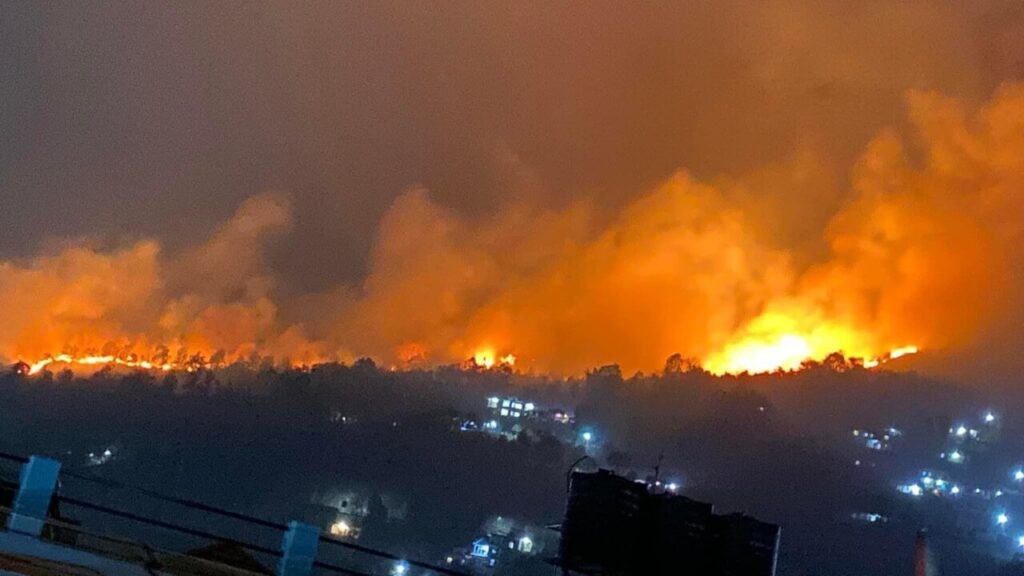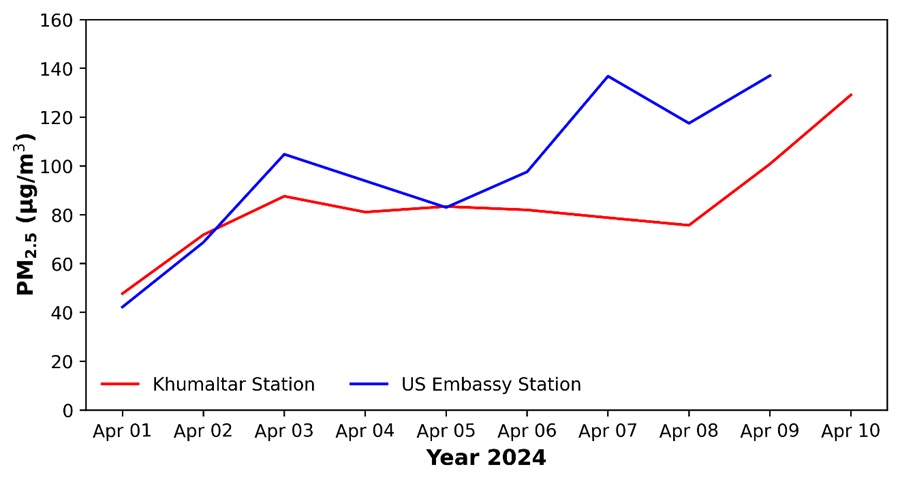Forests in Nepal’s southern and eastern districts are ablaze this spring. The Government of Nepal’s Forest Fire Detection and Monitoring System [1], developed with technical support from ICIMOD, recorded 466 forest fires in March rising to 1,174 in the first two weeks of April alone.
 [2]
[2]Drier winters, with as many as 12 out of Nepal’s last 18 winters [3] receiving lower than usual levels of precipitation, are sparking the higher numbers of pre-monsoon forest fires. Within Nepal, annual losses are put at NRS 2 billion. India, where forest fires are also on the rise, made headlines [4] this year when little to no snowfall fell in high mountain areas, including the famous ski resort Gulmarg in Kashmir.
Forest fires, as well as crop burning and open burning of waste, are responsible for toxic pollutants that are hugely harmful to human health: carbon monoxide (CO), nitrogen oxides, volatile organic compounds, fine particulate matter (PM2.5), and black carbon. Given regional weather patterns, particulate matter from forest fires in the region is being carried by winds directly towards Kathmandu.
ICIMOD data captured at the Khumaltar Air Quality Monitoring station (see below) shows that the daily average of PM2.5 particles between 1-10 April measured at 48 µg/m3 to 131 µg/m3. The World Health Organisation ranks any measurement above 5 micrograms per cubic meter (µg/m3) as hazardous. Similarly, the US Embassy station in Maharajgunj recorded a daily average PM 2.5 concentration ranging from 42 µg/m3 to 137 µg/m3 between 1-9 April.
 [5]
[5]The rising numbers of forest fires are not just due to drier winters – but also inadequate levels of forest or field management, plantations of monocultures of pine, and rising quantities of biomass from invasive species and historical efforts at suppressing fires. These factors increase fire risk.
There is no magic bullet to solve the issues of air pollution in the HKH, but a focus on forest fires would make a sizeable contribution not just to human health but also to halting and reversing biodiversity loss.
While climate change continues to influence longer term meteorological patterns, reviving traditional forest management practices would mitigate risks. These could consist of prescribed burns or early season litter fires to prevent fuel build-up that lead to uncontrollable forest fires.
In addition, Government of Nepal’s forest fire monitoring system provides near real-time mapping of fire incidents and fire outlooks for two days in advance: helping authorities understand patterns, assess severity, and take anticipatory action to prevent incidents and spread.
The accurate nationwide assessment tool is open-access to all, with ICIMOD’s SERVIR-HKH delivering training programmes to community representative and local authority stakeholders to build their capacity to collect information, assess risks, and protect at-risk communities with sharing of warning messages.
Related publications
- Exposed and exploited Climate change, migration and modern slavery in Bangladesh [6]
- Climate Risk Index 2025: Who suffers Most from Extreme Weather Events? Weather-related Loss Events in 2022 and 2000 to 2022 [7]
- Engaging States to Achieve India’s NDC [8]
- New Paradigms of Disaster Mitigation Decision Support Systems Through Applications Leveraging Earth Observations and Machine Learning Approaches [9]
- Compound weather and climate extremes in the Asian region: science-informed recommendations for policy [10]
- Notable ecological risks of microplastics to Minjiang River ecosystem over headwater to upstream in Eastern Qinghai-Tibetan Plateau [11]
- Heat adaptation: Community driven solutions in the food, energy, water nexus [12]
- Key messages and recommendations: Regional workshop on the interlinkages between health impacts of air pollution and inclusivity [13]
- Factors Influencing a Manufacturing Firm to Adopt Iso 14001 Standard [14]
- Examining Weak Sustainability for Storm Protection by Mangroves [15]